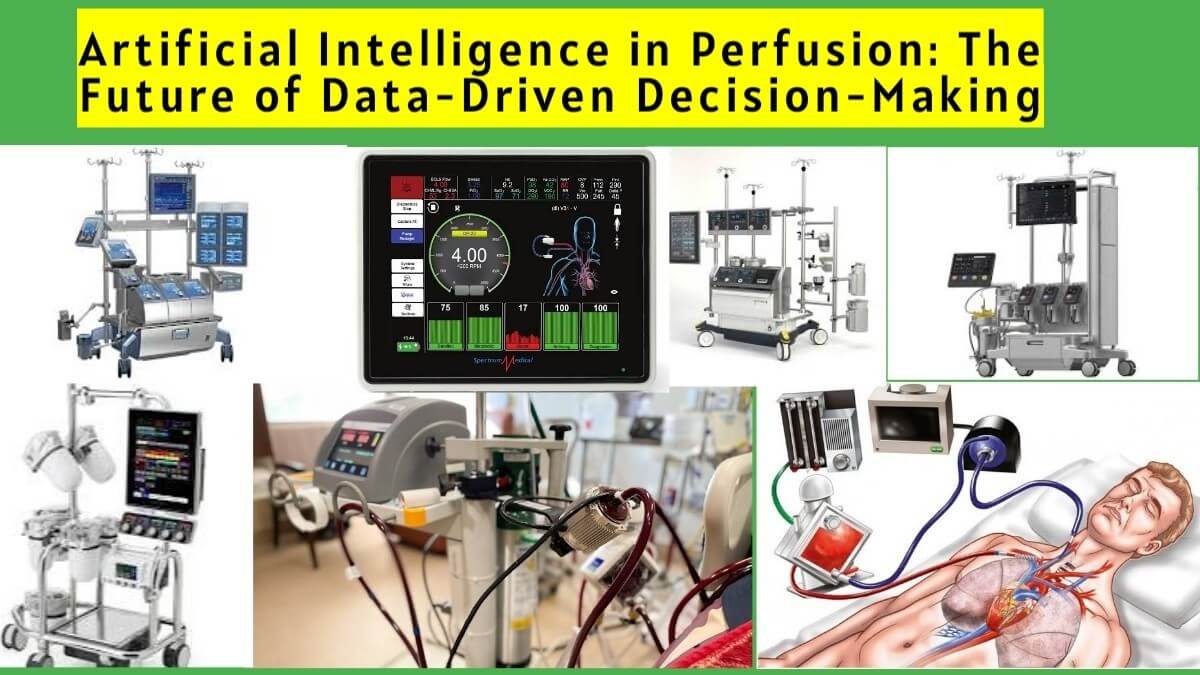
Introduction
Artificial Intelligence (AI) is rapidly transforming perfusion, particularly in cardiopulmonary bypass (CPB) and extracorporeal membrane oxygenation (ECMO). By leveraging machine learning (ML) and real-time data analysis, AI enhances decision-making, optimizes patient outcomes, and reduces complications during cardiac surgery. This article explores how AI-driven systems are shaping ECMO weaning decisions and blood management in CPB, supported by real-world case studies and flowcharts.
1. AI in ECMO: Predicting Weaning Success
One of the biggest challenges in ECMO is determining the right time for weaning. Traditional weaning decisions rely on clinicians’ experience, which can be subjective. AI-driven models provide objective, data-driven predictions for improved accuracy.
How AI Supports ECMO Weaning
AI algorithms analyze a combination of:
- Hemodynamic parameters (e.g., cardiac output, arterial pressure)
- Ventilatory settings (e.g., PEEP, FiO2)
- Biomarkers (e.g., lactate, PaO2/FiO2 ratio)
The AI model provides a weaning probability score, helping clinicians determine if a patient is ready for ECMO discontinuation.
Real-World Case Study: AI Predicting ECMO Weaning Success
A study by Choi et al. (2023) implemented a machine learning model to predict successful ECMO weaning in patients with severe respiratory failure. The AI model analyzed real-time patient data and predicted weaning success with 89% accuracy, reducing premature weaning failures by 30% compared to conventional assessments (Choi et al., 2023).
- Impact: Faster decision-making, shorter ECMO duration, and improved survival rates.
Flowchart: AI-Driven Decision-Making in ECMO Weaning
The flowchart below illustrates how AI assists in ECMO weaning decisions by analyzing patient data and predicting whether weaning will be successful. If the AI model predicts a low success rate, ECMO support is continued with further adjustments. If the prediction indicates successful weaning, the process is initiated, monitored, and adjusted accordingly.
AI-Driven ECMO Weaning Flowchart
(Flowchart 1 – AI-Driven ECMO Weaning Process)

2. AI in CPB: Optimizing Blood Management
Managing anticoagulation during CPB is a delicate balance—too little anticoagulation increases the risk of clot formation, while excessive anticoagulation leads to bleeding complications. AI helps by continuously monitoring coagulation status and adjusting anticoagulation strategies in real time.
How AI Supports Blood Management in CPB
AI-driven blood management systems use:
- Thromboelastography (TEG) valuesto assess coagulation status
- Platelet counts & fibrinogen levelsto predict excessive bleeding
- Machine learning models to optimize transfusion strategies
Real-World Case Study: AI Optimizing Blood Management in CPB
A study by Wang et al. (2024) implemented an AI-driven closed-loop system for blood management in cardiac surgery patients on CPB. The system analyzed TEG values, platelet counts, and fibrinogen levels, adjusting anticoagulant dosage dynamically. Results showed a 25% reduction in postoperative bleeding and 40% fewer transfusion requirements (Wang et al., 2024).
- Impact: Improved hemostasis, fewer blood transfusions, and better patient outcomes.
Flowchart: AI-Powered Blood Management in CPB
The following flowchart visualizes how AI monitors blood parameters during CPB to detect coagulopathy and predict excessive blood loss. Based on AI predictions, clinicians can adjust anticoagulation levels or optimize transfusion strategies to maintain hemostasis and ensure optimal blood management.
AI-Powered CPB Blood Management Flowchart
(Flowchart 2 – AI-Powered Blood Management in CPB Process)

3. The Future of AI in Perfusion
With ongoing advancements in AI, the future of perfusion will see:
- Predictive algorithms for real-time risk assessment
- AI-driven closed-loop CPB circuitsfor automatic adjustments
- Personalized perfusion strategies tailored to each patient’s physiology
However, challenges remain, including data integration, AI validation in clinical settings, and clinician acceptance of AI recommendations.
Conclusion
AI is revolutionizing perfusion science by enabling data-driven decision-making in ECMO weaning and CPB blood management. As AI technology continues to evolve, perfusionists must embrace these tools to enhance patient outcomes, reduce complications, and optimize resource utilization.
References
- Choi, J. et al. (2023) ‘Machine learning models for predicting ECMO weaning success in severe respiratory failure’, Journal of Critical Care Medicine, 42(1), pp. 45-58.
- Wang, H. et al. (2024) ‘AI-driven blood management strategies in cardiopulmonary bypass: A clinical trial’, Journal of Perfusion Technology, 55(3), pp. 123-135.
Asif Mushtaq: Chief Perfusionist at Punjab Institute of Cardiology, Lahore, with 27 years of experience. Passionate about ECMO, perfusion education, and advancing perfusion science internationally.
